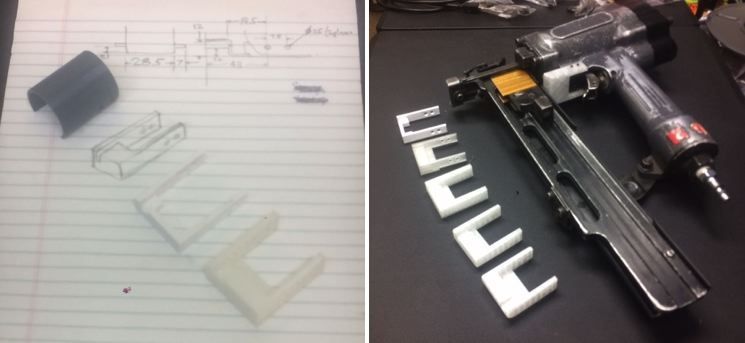Case Study: Rapid Design Iteration and Prototyping
- Posted on
- 0

Our client from SouthernCarlson, Paul Vanderboom, asked us to produce trigger covers for nail guns that would prevent users from accidently depressing the “multi-shot” trigger located above the main trigger. The first solution, shown in gray in the left image, was a 3D-printed replica of a crude cover cut by Paul from PVC pipe. That solution didn’t really work: the PLA half-pipes broke easily, and were too big and bulky, getting in the way of the main trigger on the nail gun.
Paul asked us to design a better trigger cover. Over the course of two days, we took up the challenge. First, using a digital caliper, we carefully measured and recorded the features on the nail gun itself. Next, we created the first design and built it in PLA. The result: too stiff—it broke while trying to install it over the row of double pins on the nail gun. The next design was too loose, and the cover interfered with moving parts on the nail gun. We decided our flexible filament, TPU, might work well for this application. We built a third and fourth prototype, refining the design each time, until we settled on a TPU design that fit snuggly, did not interfere with any moving parts, and fully satisfied the design goal of protecting the user from accidentally pulling the wrong trigger. It's shown in the right photo, installed on the nail gun.
This exercise really demonstrates the power of three important concepts used in combination: 1) iterative design—the more times you can evaluate and improve a design, the better; 2) collaboration—everyone in our shop either participated actively or commented on the progression of the design, and their input made the final product better; and 3) 3D printing—being able to quickly print the prototypes, assess them, and fit test them to the nail gun clearly revealed the improvements that were needed in the design of the trigger cover.
It’s no wonder that 3D printing was called “Rapid Prototyping” for nearly 20 years after it was first commercialized. 3D printing is a powerful tool for rapid design iteration that results in better products at lower costs with faster design cycle times. THIS is the power of digital design and manufacturing.


Comments
Be the first to comment...